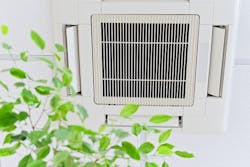Need to Virus-Proof Your Building? Follow the Data
The world wants “back to normal.” Businesses left and right are calling employees back to the office. Countries are dropping mask and proof of vaccination mandates as fast as possible—despite the threat of new variants. It’s understandable.
But this immutable fact gives us all pause: we spend 90% of our lives inside, which is where 999 of 1,000 COVID infections occur. At home, we can choose the ventilation; not so in the office. And it’s been proven that indoor air can be five times as polluted as outdoor air.
Employees today are more aware of situational health factors—especially indoor air quality (IAQ) and ventilation—than ever before. According to our research, 63% of employees worry more about workplace healthiness than they did before the pandemic, and 58% would feel better returning to the workplace if their employer used data (about IAQ and other factors) to improve their workplace.
And a new trend is emerging: employees want data showing the safety level of their work environment.
[Related: How a Cultural Shift in Air Quality Will Keep People Safe]
The $64,000 Question
Is your building healthy? That’s a tough question to answer. We still live in an era of “dumb” buildings with little technology to track something as basic as air quality.
But it’s the buildings ahead of the technology curb that will do better by their employees. Such buildings are equipped with fleets of sensors that measure everything from humidity to gasses, such as ozone, and particulate matter.
Let’s take humidity as an example of an important IAQ factor to track continuously. Why humidity? Because transmissibility of cold and flu viruses is reduced by 70% if indoor humidity is kept between 40% and 60%.
Another incredibly useful metric is CO2, which makes employees feel sluggish and unable to concentrate. Sensors can also track volatile organic compounds (VOCs), which are emitted by thousands of products from carpets to cleansers and office printers. Some VOCs can cause liver damage, vision disorders and memory impairment, so they’re not to be taken lightly.
Baby Steps: Making Your Building Healthy
You’re probably thinking: measuring for humidity and CO2 makes sense, but how do I go about it? Where do I start? What do I have to rip and replace?
One thing to keep in mind is that the answers lie in data which is collected via simple, easy-to-deploy sensors. The key is to know what to look for and steps to take as an organization to keep your employees informed of building status. Here are some examples:
- Install and maintain automated air-filtration systems that detect and reduce airborne pathogens and can help compensate for lack of fresh-air ventilation.
- Install systems for heat profiling to detect employees with fevers and alert them that they are potentially contagious.
- Set up alerts to employees to relocate within the office to avoid people running a high temperature, a low-humidity spot or a high-CO2 conference room.
- Alert employees if less crowded offices and conference rooms are available.
- Make buildings more comfortable by matching temperature and ventilation to the number of people.
In addition, sharing information about IAQ measures and having dialogue with employees about their specific health concerns can increase workplace healthiness.
[Related: IAQ Gets an Upgrade During COVID-19]
More is More—At Least When It Comes to Data
Many public health and healthy building advocates are adamant that legally acceptable IAQ is actually unacceptable, because we should breathe clean air, and getting clean air is worth the effort. Cognitive function, for example, is measurably impaired at commonly accepted CO2 levels. Their view is that a revolution in workplace designs is overdue. It may be impractical to install open windows in skyscrapers, but real-time data on the functioning of existing ventilation and filtration components is a must.
There’s a balance to aim for optimal results; with ongoing readings of IAQ levels that guide adjustment of ventilation and filtration, a building can flush out pathogens yet filter incoming air to clean out urban pollutants. Surprisingly, more external pollution is inhaled inside buildings than outdoors because most people are indoors.
During 2020 and 2021, we saw how rigid building design impeded adding fresh-air ventilation. In some cases, buildings simply were not designed to allow it. It makes good business sense to give employees access to ongoing readings on air quality.
Data is everyone’s ally against invisible menaces, as we’ve learned the past two years.
In Summation
For new buildings and retrofits, healthiness and real-time monitoring of IAQ are the new priority, ahead of energy efficiency and even physical security. The sensors, platforms and practices are here to warn facilities and employees of pollutants, malfunctioning filtration and conditions that increase spread of infections.
Now is the time to focus on health and buildings. Returning employees are not just aware, they want to be kept informed. They’re not willing to give up health precautions for work—not after the pandemic, and not in this job market. A sufficient flow of IAQ data will help keep them safe, sustain their productivity in the office and help make your company more attractive to employees in a way that few thought of before the pandemic.
About the Author:
William Cowell de Gruchy is the CEO of Infogrid.
Read next: COVID-19: Are Building Managers Measuring the Right Air Quality Parameters?
About the Author

Contributed Author
BUILDINGS partners with industry experts to bring you contributed content covering the hot topics for building owners and facility professionals.
